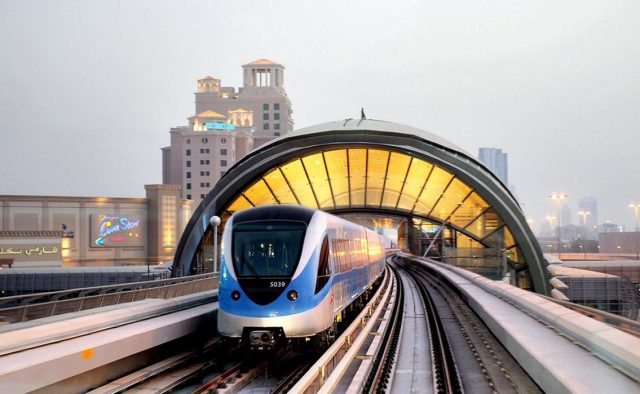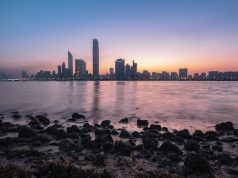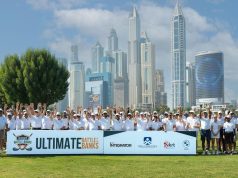UAE celebrates 10 years of smooth journeys and happy memories created. From people of all ages and all nationalities UAE’s most ambitious project, the Dubai Metro, turns 10 on Monday.
Launch of Dubai Metro Operation
The first decade of Dubai Metro operation, launched on September 9, 2009 (9.9.9), has been marked by fabulous successes reflected by a massive number of more than 650,000 commuters currently using the service every day. In total, more than 1.5 billion riders have used the metro over the last 10 years.
Roads and Transport Authority (RTA) of Dubai launched the metro journey at 09:09:09 pm on a Wednesday, the 09.09.2009. His Highness Sheikh Mohammed Bin Rashid Al Maktoum, Vice-President and Prime Minister of the UAE and Ruler of Dubai, inaugurated the Red Line of Metro spanning 52km and comprising of 29 stations (4 underground, 24 elevated and one at-grade). The red line runs between Jebel Ali and Rashidiya.
Dubai Roads and Transport Authority (RTA) launched the metro journey at 09:09:09 pm on a Wednesday, the 09.09.2009. His Highness Sheikh Mohammed Bin Rashid Al Maktoum, Vice-President and Prime Minister of the UAE and Ruler of Dubai, inaugurated the Red Line of Metro spanning 52 km and comprising of 29 stations (4 underground, 24 elevated and one at-grade). The red line runs between Jebel Ali and Rashidiya.
Exactly two years later, on 09.09.2011, Sheikh Mohammed launched the Green Line, extending 23km and comprising 18 stations (6 underground and 12 elevated). The Green Line runs between Etisalat Station in Al Qusais and Al Jaddaf near Business Bay Crossing.
The two lines intersect at the Union and Burjuman stations. It is the world’s largest automated driverless system. And a bona fide tourist attraction.
“Dubai Metro is a brainchild of Sheikh Mohammed as it reflects his prudent vision for developing world-class infrastructure capable of symbolising Dubai as a global hub for finance and business,” said Mattar Al Tayer, Director-General and Chairman of the Board of Executive Directors of Roads and Transport Authority (RTA).
In an exclusive interview with Gulf News, Al Tayer said that Dubai Metro’s concept was driven by Sheikh Mohammed’s vision for the the urban development of the emirate.
“Sheikh Mohammed projected the metro system as the backbone of a transit system that connects hotspots in the emirate, providing safe and smooth mobility for all. To match that supreme vision, Sheikh Mohammed directed to construct metro facilities par excellence,” recalled Al Tayer.
Stand-out project
Al Tayer noted that the news of the Metro’s success have travelled far beyond the emirate.
“The metro has embellished the global profile of Dubai as a splendid metropolis, business hub, and a destination for a fancy living environment.
“The metro is a gorgeous addition to Dubai’s iconic landmarks and uses state-of-the-art technology of the rail industry. Also, it has carved a niche for itself as the world’s longest driverless metro network,” said Al Tayer.
Ridership on the go
RTA’s Director General was impressed by the growing metro ridership, which reveals that RTA’s plan for increasing the share of public transport riders is heading in the right direction.
“The growing number of metro users reflects the evolution in the culture of using mass transport means in the community. People started grasping the benefits of using public transport such as the peace of mind, physical relief, smooth mobility and reduced outlay on fuel and maintenance of vehicles,” he noted.
Massive increase in ridership
From the start of operations on 09.09.2009 until the end of August this year, Dubai Metro was used by about 1.5 billion riders.
The number of metro riders soared from about 39 million in 2010 to as much as 69 million the following year. With the launch of the Green Line in September 2011, the number of Metro riders rocketed to 109 million in 2012.
The ridership continued to grow and in 2015, it reached 179 million; by the end of 2018, it broke the two-hundred-million barrier; clocking 204 million riders.
“Currently, Dubai Metro serves about 650,000 commuters daily; a record that significantly surpasses the number forecasted in studies commissioned at the design phase of the project,” confirmed Al Tayer.
Benefits from Metro
The successful operation of Dubai Metro resonates with RTA’s strategic objective of raising the share of public transport used in intra-emirate travel to 26 per cent by 2030.
Public transport shares started to make incremental growth starting at 6 per cent in 2006 and going up to 17.5 per cent in 2018, recording a cumulative growth rate of about 9.3 per cent per annum.
“The massive investments of Dubai Government in the public transport infrastructure proved a hit,” said Al Tayer, the man behind realising the dream of mass transit system in Dubai.
“It supported the flourishing development witnessed by the Emirate and provided a stimulant for business and tourism.
“Public transport contributed to the safe and smooth mobility, improved business climate and enhanced the competitive edge of Dubai in hosting mega-events. Expo 2020 is an example.
“The indirect benefits of public transport includes conserving the environment, and cutting financial losses of traffic bottlenecks through deflecting the demand from private vehicles to public transit means,” Al Tayer explained.
Team effort
Al Tayer did not let the occasion of the Metro’s 10th anniversary go without commending the efforts of RTA’s strategic partners and their contribution to the successful operation of Dubai Metro.
“Above all comes Dubai Police, and Serco, the operator of the metro network,” he said.
He also thanked commuters who made the metro their ideal mobility choice and praised their compliance with the rules governing metro operation and facilities.
No vandalism
Al Tayer said that it is amazing to note that in the past ten years, no act of vandalism that targeted metro facilities was reported.
Performance indicators of the Dubai Metro over the past decade reveal very high operational standards. The on-time departures of the metro service, from inception until August 2019, clocked in at 99.7 per cent.
Metro completes 81 million km
The metro completed 2.348 million journeys and covered about 81.133 million km in the first 10 years.
Through the metro service, RTA aims to improve mobility within Dubai, especially in tourist areas and central business districts. It also seeks to enhance the integration of mass transit modes in the emirate, provide a safe and smooth transit alternative, reduce carbon emissions and improve the living experience of people.
Six billion transactions
From the start of the metro operation in September 2009 to the end of August 2019, about 6.298 billion transactions have been made using Nol cards.
Transactions covered entry/exit from metro stations, buses, taxis and marine transport as well as payment of parking fees, and card top-ups. The daily use of Nol cards is on the rise and has grown to 2.511 million transactions.
The total number of Nol cards and tickets amounted to 75.588 million.
What is an automated fare system?
RTA’s automated fare collection system, comprising of Nol cards and e-purse, is a key smart payment platform. It supports the government’s efforts to transform Dubai into the smartest and happiest city in the world. Nol card boasts of high safety features, thanks to the sophisticated technologies in use. It has scooped several awards including the best-prepaid card in the Middle East.
The e-purse is a prepaid online account for prepayment of RTA’s services. Companies can make deposits to the e-purse account instead of using cash or credit cards. About 1,700 processed through the purse are worth about Dh1.136 billion.
Metro extension: Route 2020
On June 29, 2016, Sheikh Mohammed okayed awarding the contract of the Route 2020 Project, for extending the Dubai Metro Red Line from Nakheel Harbour and Tower Station to the site of Expo 2020. The contract was awarded to Expolink Consortium comprising French, Spanish and Turkish companies at a cost of Dh10.6 billion.
On September 5 of the same year, Shaikh Hamdan Bin Mohammed Bin Rashid Al Maktoum, Dubai Crown Prince and Chairman of the Executive Council, laid the cornerstone of Route 2020 Project signalling the start of construction works in the project.
Route 2020 extends 15km (11.8km viaduct, and 3.2km underground). It has seven stations including a transfer station with the Red Line, a station at Expo site, three elevated stations and two underground stations.
It serves densely populated areas providing homes to more than 270 thousand residents such as The Gardens, Discovery Gardens, Al Furjan, Jumeirah Golf Estates and the Dubai Investment Park.
The transit time from Dubai Marina Station to Expo Station is expected to be only 16 minutes. The capacity of Route 2020 is estimated as 46,000 riders per hour in both directions (23,000 riders per hour per direction).
According to RTA’s studies, the ridership of Route 2020 is expected to reach 125,000 per day in 2020; and the number is set to rise to 275,000 riders per day by 2030. Studies also anticipated that about 35,000 riders would use the Expo Station per day during weekdays, and that number is poised to rise to 47,000 riders per day during weekends. This number accounts for about 20 per cent of the projected total number of daily visitors to Expo.
Quick facts:
- Dubai Metro extends 75 km: 52km on the Green Line and 23km on the Green Line.
- The metro route is partly underground (downtown areas), and the rest is an elevated track. A limited sector of the Red Line (about 3.3 km) runs above-ground.
- Each metro train comprises of five fully air-conditioned cabins with a total capacity of 650 riders. All trains are driverless.
- There are 79 trains available for the metro service in total. Trains in service include 51 on the Red Line and 16 on the Green Line.
- The design capacity of the metro network is 26,000 riders per hour per direction in both the Red and Green Lines. By 2020, the Dubai Metro is anticipated to serve about 700,000 riders per day and 255 million riders per annum.
- Three multi-level Park-N-Ride terminals have been constructed with a capacity of 8,000 parking slots.
- The interior design of the metro stations on both the Red and Green Lines as well as Route 2020 features six symbolic design themes:
- Heritage: Culture and history of the UAE
- Earth: Durability of nature
- Air: Elation and continuity of life
- Fire: Source of energy and strength
- Water: Source of life and inspiration
- Future Dubai symbolised in Expo Station
October 24, 2005:
Construction work on Dubai Metro Project starts at Al Ittihad Park in Deira.
November 2005:
Shaikh Maktoum Bin Rashid Al Maktoum issued a decree setting up Dubai Roads and Transport Authority, which have direct jurisdictions and responsibilities over Dubai Metro sector
March 21, 2006:
His Highness Shaikh Mohammad Bin Rashid Al Maktoum, launched the construction work of Dubai Metro in an official event held at Madinat Jumeirah, Dubai.
July 29, 2006:
The first concrete pillar of the Dubai Metro viaduct, between the sixth and seventh interchanges on Shaikh Zayed Road, is cast.
January 10, 2007:
His Highness Shaikh Mohammad launches the drilling of Dubai Metro tunnels by pressing the operation button of the giant Tunnel Boring Machine, Al Wugeisha, at the site of the Union Station in the direction of Burjuman Station.
March 07, 2008:
The first batch of Dubai Metro carriages (10 trains) arrives at Jebel Ali Port.
September 20, 2008:
Shaikh Mohammad launches the technical trial run of Dubai Metro on the test track.
September 09, 2009:
Shaikh Mohammad launches the commercial operation of the Red Line starting with ten stations.
September 09, 2011:
Shaikh Mohammad launches the commercial operation of the Green Line of Dubai Metro.
November 07, 2011:
Dubai Metro surpasses the milestone as more than 100 million passengers use the service since its launch on September 9, 2009.
June 13, 2015:
The RTA unveils plans to extend the Metro tracks to 110km by 2020 and to 421km by 2030.
September 09, 2017:
Dubai Metro crosses a billion-rider mark.

















